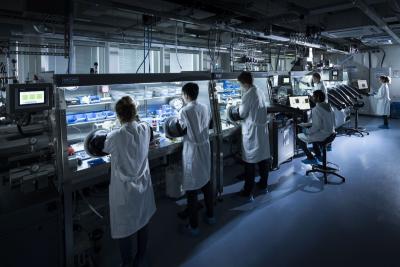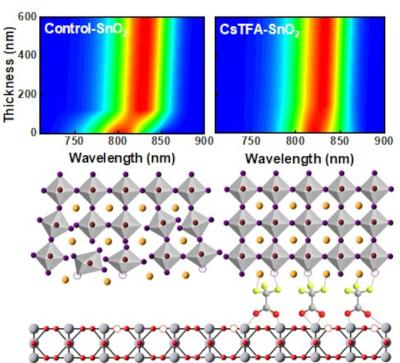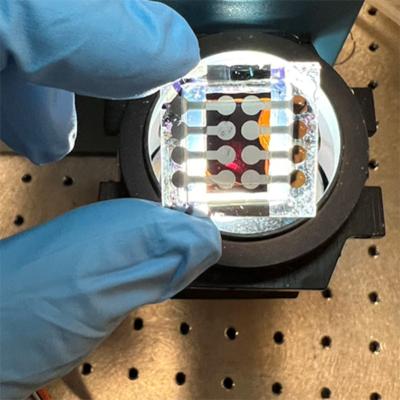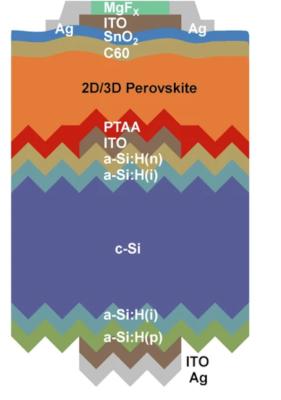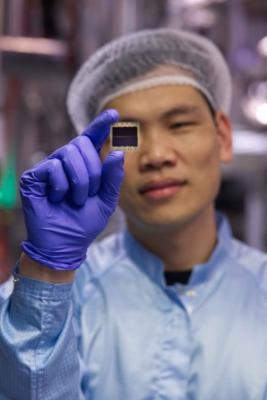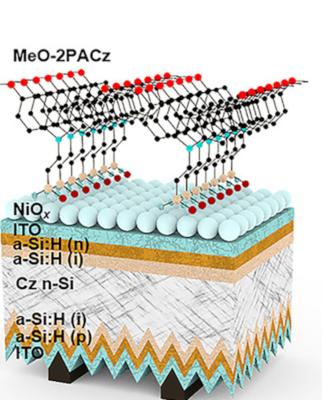Perovskite Solar - Page 10
New platform by Germany's Helmholtz Association to promote multi-benefit photovoltaic applications
A collaborative project by leading Helmholtz Centers for photovoltaic research aims to accelerate the deployment of multi-benefit photovoltaics based on emerging printed PV-Technologies like organic photovoltaics and perovskites.
Core Lab Perovskite PV at KIT. Image from Solar TAP website
The Solar Technology Acceleration Platform (Solar TAP) for emerging Photovoltaics brings together 3 Helmholtz Centers, 9 major research infrastructures, and more than 25 scientists. The three Helmholtz centers are: Forschungszentrum Jülich, Helmholtz Zentrum Berlin and Karlsruhe Institute of Technology. They are aligning their world-class infrastructures in order to create the joint Technology Acceleration Platform and providing fast and simple access to laboratories, equipment and scientists through collaborative pre-financed projects.
Hanwha Q CELLS to focus on rapid commercialization of tandem PSCs
Hanwha Q CELLS, according to BusinessKorea, is shifting its strategy from research and development to rapid commercialization in the field of tandem solar cells. This strategic pivot comes, as was reported, as Chinese companies invest heavily in improving tandem energy efficiency.
Hanwha Q CELLS is reportedly set to complete the final inspection of its 40MW perovskite-tandem cell pilot line in Jincheon, Chungbuk, as early as October this year and begin trial operations. The company aims to start commercial production by 2026, believing that entering mass production ahead of China is crucial to gaining the upper hand in the market.
UNIST researchers improve the efficiency and stability of PSCs by introducing bidirectional tuning molecules between the perovskite photoactive layer and ETL
BusinessKorea reports that researchers at the Ulsan National Institute of Science and Technology (UNIST) have significantly improved the efficiency and stability of perovskite solar cells by addressing defect issues.
Schematic of perovskite crystallinity changes and thickness-based photoluminescence analysis through the introduction of bidirectional tuning molecules. Source: BusinessKorea, UNIST
The UNIST team announced that a joint research team, led by Professors Kim Jin-young and Kim Dong-seok from the Department of Energy and Chemical Engineering, and Professor Lee Geun-sik from the Department of Chemistry, successfully introduced bidirectional tuning molecules between the perovskite photoactive layer and the electron transport layer.
Researchers use diamine chelates to increase stability in mixed Sn–Pb and all-perovskite tandem solar cells
An international team of researchers, including ones from the University of Toronto, University of Toledo, Northwestern University, Lawrence Berkeley National Laboratory, KAUST and more, recently developed an all-perovskite tandem device that is said to show reduced recombination losses in the cell’s bottom device and excellent stability.
Image credit: Northwestern University
To improve the perovskite solar cell’s surface, the scientists created partially non-conductive and non-functional areas that protect the perovskite area underneath from becoming defective. The team examined the addition of diamine to improve the perovskite solar cell’s surface. The scientists found that the process made the surface more stable and improved the overall performance, resulting in a power conversion efficiency of 27.4% with better stability.
A novel binary 2D perovskite passivation approach enables efficient and stable perovskite/silicon tandem solar cells
Researchers from China's Beijing Institute of Technology, Peking University, Central South University, Jiangnan University and Auner Technology have developed a unique binary 2D perovskite passivation approach and used it to fabricate a monolithic perovskite/silicon tandem solar cell with a steady-state efficiency of 30.65% (reportedly assessed by a third party).
Schematic of the monolithic tandem structure based on a double-side textured silicon heterojunction cell. Image credit: Nature Communications
The tandem devices also retained 96% of their initial efficiency after 527 h of operation under full spectral continuous illumination, and 98% after 1000 h of damp-heat testing (85 °C with 85% relative humidity).
Oxford University team develops perovskite solar coatings that could be placed on everyday objects
Scientists at Oxford University Physics Department have developed thin-film perovskite coatings that could be placed onto the surfaces of everyday objects like cars and mobile phones to generate increasing amounts of solar electricity without the use of silicon-based solar panels.
Dr Shuaifeng Hu, Post Doctoral Fellow at Oxford University Physics, holding the new thin-film perovskite material. Image credit: Martin Small and Oxford University.
The light-absorbing material is said to be, for the first time, thin and flexible enough to apply to the surface of almost any building or common object. Using a pioneering technique developed in Oxford, which stacks multiple light-absorbing layers into one solar cell, they have harnessed a wider range of the light spectrum, allowing more power to be generated from the same amount of sunlight.
Researchers couple excitons to polaritons for better solar cells and LEDs
Solar cells and light-emitting diodes strive to maintain the excited state kinetics of molecules. A major loss mechanism, especially in the highest efficiency systems, is called exciton-exciton annihilation, leading to lowering of solar efficiency and of light output in LEDs. Controlling the amount of exciton-exciton annihilation is therefore an important goal that affects efficiency.
National Renewable Energy Laboratory (NREL) researchers, working with researchers from University of Colorado Boulder, sought to control exciton/exciton annihilation by coupling excitons with cavity polaritons, which are essentially photons caught between two mirrors, to combat energy dissipation and potentially increase efficiency in optoelectronic devices. As detailed in their recent article, the scientists used transient absorption spectroscopy to demonstrate control of the loss mechanism by varying the separation between the two mirrors forming the cavity enclosing the 2D perovskite (PEA)2PbI4 (PEPI) layer. This perovskite material is a candidate for future LED applications.
Researchers use hybrid interconnecting layers to achieve perovskite-silicon tandem solar cell with 28.47% efficiency
Researchers from China's Jinan University, University of Macau, Wuyi University, Guangdong Mellow Energy and Germany's IEK-5 Photovoltaik (Forschungszentrum Jülich) recently designed a two-terminal perovskite-silicon tandem solar cell that utilizes new hybrid interconnecting layers to reduce recombination losses in the top perovskite device. The tandem cell achieved an impressive fill factor of 81.8%, which the scientists said is the highest value ever reported for this cell technology to date.
The team's 2T perovskite-silicon tandem solar cell is based on special hybrid interconnecting layers (ICLs) that prevent direct contact between the perovskite absorber and transparent conductive oxide (TCO). The scientists' approach is based on sputtered nickel oxide (NiOx) as the seed layer of SAMs to build the hybrid interconnecting layers. The sputtered treatment technique provides, according to the team, an easy coating on a complex substrate and high reproducibility.
Researchers use chiral-structured interface to enhance the durability of perovskite solar cells
Researchers from NREL, Yale University, Hong Kong Baptist University and The Hong Kong University of Science and Technology (HKUST) have designed a chiral-structured interface in perovskite solar cells, which reportedly enhances their reliability and power conversion efficiency.
Using the PSC developed by the team to power a mobile phone as a demo. Image from Techxplore, credit HKUST
The performance of PSCs still faces significant barriers to commercialization, particularly due to various stability issues under real-world conditions. A major challenge is, according to the team, the insufficient adhesion between the different layers of the cells, resulting in limited interfacial reliability. To address this issue, the team was inspired by the mechanical strength of natural chiral materials and constructed an unprecedented chiral-structured interface in PSCs, unlocking very high reliability.
University of Michigan team awarded funding to promote perovskite solar technology in transportation
The Michigan Translational Research and Commercialization Advanced Transportation Innovation Hub has awarded over $1.5 million to 15 projects driving commercial potential in transportation technologies.
Among the recipients are Assistant Professor of Chemical Engineering Xiwen Gong, whose research addresses the challenges in the large-scale production of perovskite solar cells. Gong’s project aims to create low-cost, large-scale perovskite solar cells with high efficiency and stability needed for potential applications in the electric and hybrid vehicle and industry.
Pagination
- Previous page
- Page 10
- Next page
